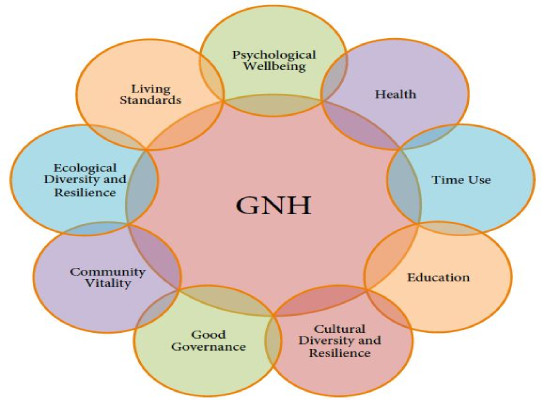When we think about how well a country is performing one thing that comes to our mind is the economic development. But is it correct to exclusively think about economic development? What about the emotional and mental well being of the people living in the country? What about happiness of the people living in the country? While economic development is important, it is also important to invest in other aspects that satisfy the conditions of human happiness. Mental well being, and affluences, fulfillment of one’s desires, human relationships, development of one’s potentialities, one’s own physiological state, faith in a religion and spirituality are some of the variables considered as relevant and significant in terms of identifying happiness.
Most countries in the world measure the development and the progress of country on the basis of GDP. If GDP would have been the only factor leading to national happiness, then booming economies of China and USA would have occupied the top position in WHR 2020. A country may achieve a high rate of growth in GDP but this may lead to joblessness, increased inequality in incomes, social unrest and general lack of wellbeing which is essentially the present case of India. Most importantly, GDP alone does not measure what a citizen wants. It generally treats humans as maximisers of rational utility. So there are some other factors supplementary to the financial prosperity that accounts for the happiness and well-being of the country. After all wellbeing and happiness are subjective experiences; material facilities and surroundings may only create a favorable environment to enjoy satisfaction and happiness. Bhutan was first country to measure the affluence of its people on the basis of GNH (gross national happiness) which not only gives importance to goods and service provided by the country but also to its people and their happiness. The term GNH was coined by Sicco Mansholt, one of the founders of the EU. Gross national happiness supplements the concept of gross domestic product with more holistic measure of development. Today gross national happiness is recognized as a scale of promotion and prosperity along with rapid growth. The basis of the concept of Gross national happiness is the emotional, psychological and mental wellbeing of the people in the nation which will therefore show an increase in the overall happiness level in the nation giving way to faster development of country.
Gross national happiness (GNH)
A multidimensional formative approach that tries to achieve a symphonic balance between material prosperity and emotional, spiritual, and social needs of individuals living in a society is known as Gross National Happiness. The idea of GNH was first proposed in 1972 by former Bhutan king, Jigme Singye Wangchuk and slowly this idea evolved into a socioeconomic model for holistic development in the Himalayan kingdom country. It is based on the conviction that material wealth alone does not bring happiness and wellbeing to people and that modernization should not be at the expense of people’s quality of life and traditional values. It includes a gross happiness index which is used for measuring collective happiness and well-being of a population. Bhutan conducts a survey once every five years which helps them in planning and making policies in a more systemic way.
In 2011 the UN general assembly passed a resolution placing this idea on the global development agenda urging member nations to follow the implemented model of Bhutan and measure happiness and wellbeing. GNH is valuing overall happiness as a goal, by emphasizing harmony with nature and traditional values as expressed in 9 domains of happiness and 4 pillars of GNH. The four pillars are; sustainable and equitable socio-economic development; environmental conservation, preservation and promotion of culture, and good governance. These pillars are divided into nine general domains which articulate the different elements of GNH in details and form the basis of GNH measurement, indices and screening tools. The nine domains are health, education, community spirit, mental prosperity, time-use, cultural diversity and resilience, good governance, environment and living standards. To understand how these domains work with one another, let us consider an example of two persons. One person has a high paying job but has less time for family and friends and other person has a lower paying job but has more time for friends and family. If we see from an economic point of view the first person adds economic value to the country more than the second person but it would be considered the opposite in the philosophy of GNH.
India- a look at its performance in the WHR 2020 (world happiness report)
It is worthwhile to note India is constantly getting degraded in its ranking in WHR since 2015. It has dropped down to 144th place out of 156 nations in WHR 2020. India lags way behind in happiness which could be due to the recent staggering slowdown in economic development. To compound the problem, in India sufficient emphasis has not been given to environment protection evidenced in easy clearing of the environmental impact assessment report for mining projects. India is recently witnessing a spiraling out of cases of corruption prevalent in the governance, in the midst of fast paced urbanization and resultant migration. These make India perform poor in community and psychological wellbeing, and growing income inequality. This clearly indicates lack of comprehensive approach towards development.
The pursuits of happiness are closely bound to search for sustainable development. A narrow vision that relies on economic development may give us better economic growth but diverts our focus from environmental sustainability, social welfare, and mental wellbeing of people. These are the prime reasons that our rank has been dropping in world happiness index year by year. The government is very keen to score high in the ease of doing business, but it seems to elude them that most people are not getting the fruits of the national development when their immediate environment is being mangled. True development and happiness have long eluded these excluded people at the bottom of the pyramid, mostly in the rural domain, and in the natural environments of India.
Finland tops the happiness list despite not having the highest GDP among the Nordic countries. It is the country’s social safety net combined with personal freedom and superior work-life balance that gives it the edge. The immediate neighbors of India including Pakistan (66th rank), Bhutan (95th rank) and Nepal (92nd rank) are way ahead in happiness ranking. Among the other south Asian nations the different parameters in which India stood higher than Pakistan were dystopia, healthy life expectancy and freedom to make life choices. However other variables like social support and generosity were reported better in Pakistan when compared to India. Also India must make efforts to adopt and learn from some of the innovation of our small Himalayan neighbor, Bhutan who has been doing well in happiness report. A tiny nation between India and china, Bhutan has recorded zero death and next to no job losses in the current COVID-19 situation. A low middle income country has managed to avoid the worst outcome of crisis with its unique approach to development i.e. working on the gross national happiness index, as asserted by the director of the Center for Bhutan and GNH studies. Incorporation of GNH is the reason that 72% of country’s land is under forest cover because they do not have a single minded pursuit of economic growth which might destroy environment. That environmental maintenance is crucial to emotional wellbeing is grasped well in the national psyche of Bhutan.
Possibility of import of the idea of GNH in India
It may be good in this context to adopt the idea of gross national happiness. Ideas do play an important role in making policies. India may need its own version of Gross National Happiness indicator that incorporates the unique character and composition of its people. Such measure will help to ensure that India’s immense diversity is preserved and rewards of development is shared equally, with the social capital preserved, social and environmental heritage strengthened and the nation becoming stronger and more united. We are still deeply rooted with social problems such as poverty, unemployment, child labour, population, illiteracy, and other issues like race to richness. People are not happy with policies, prevalent corruption, ecological degradation and many more problems which are generally looked over in the policy making.
In the present time a couple of key initiatives are being taken in India towards happiness development. Madhya Pradesh government has shown interest to work on the gross national happiness concept and create Ananda Ministry or Ministry of Happiness in 2016. During this pandemic they engaged their happiness department to reduce stress of Corona virus patients and boost the morale of front line officials by using music, films, inspirational messages, entertainment programs through audio visual means at Covid-19 hospitals and quarantine centers. Goa government in its vision document 2035 has decided to work on GNH concept of Bhutan by having four pillars such as Cultured Goa, Sustainable Goa, well Governed Goa, and Happy Goa. Indian government in their policies took initiatives towards environmental cleanliness, make India a good place to live in using different ways like Swach Bharat Abhiyan and Odd-Even Formula to reduce pollution. There are some private spiritual organizations working in this direction like Art of living, Patanjali Yoga Piitha, Ghanaian peace foundation and Ishayog foundation.
India needs an empathic effort for happiness whose goal is not confined to just improving the dull rank in Global happiness index. Gross national happiness approach must focus on human behavior and consumption management which is the guide for the demand side of sustainable development. Many governments around the world like Venezuela, UAE, and Bhutan have considered including a measure of happiness for purpose of guiding economic policy making towards growth. India requires a holistic approach of happiness for development and growth through various measures that provide inner happiness. It is time that we as Indians took measures of gross national happiness along with economic growth seriously and adapt them to our conditions. It is in the need of our greater good to have a better measure of national wellbeing along with ecological sustainability.





